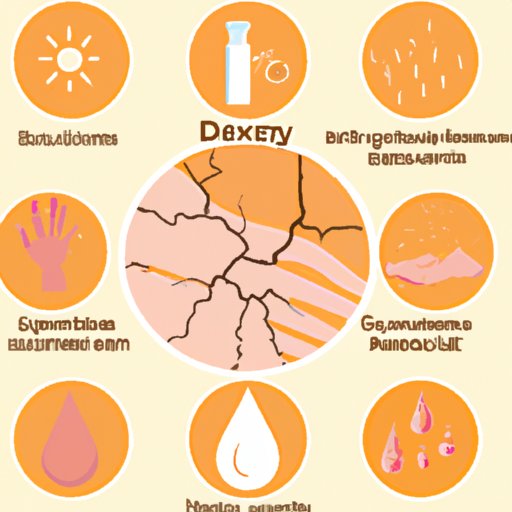Introduction
Dry skin is a common skin condition that affects millions of people worldwide. It can cause discomfort, itching, flaking and even cracking of the skin. While it is not usually a serious medical issue, it is important to know what to look for in order to properly treat and prevent it. In this article, we will look at what dry skin looks like, its common symptoms, causes and prevention tips, as well as home remedies and treatments for various skin conditions associated with dryness.

How to Identify Dry Skin
The most obvious symptom of dry skin is a feeling of tightness on the surface of your skin, especially after showering or washing your hands. Additionally, you may experience itchiness, redness, flakiness, and even cracking. These symptoms are usually more severe in areas such as the hands, feet, elbows and knees. You may also notice that your skin appears dull and lacks its usual luster.
Causes of Dry Skin and Prevention Tips
There are many environmental factors that can contribute to dry skin. These include cold weather, wind, low humidity, and exposure to harsh chemicals or detergents. Diet can also play a role in skin dryness, as certain foods (such as processed foods) can contribute to poor skin health. Additionally, lifestyle choices such as smoking and drinking alcohol can also have a negative impact on skin hydration.
Fortunately, there are several steps you can take to help prevent and treat dry skin. First, make sure to drink plenty of water throughout the day to stay hydrated. Secondly, apply a moisturizer every day to keep your skin hydrated and protected from the elements. Additionally, try to avoid long hot showers or baths, as these can strip away the natural oils from your skin. Lastly, wear protective clothing such as gloves and hats when going outside in cold or windy weather.
Home Remedies for Treating Dry Skin
There are several home remedies you can use to help relieve the symptoms of dry skin. One of the best options is to use natural oils such as coconut oil, olive oil, or almond oil. These can be applied directly to the skin or mixed with other ingredients to create a nourishing moisturizer. Additionally, using a humidifier in your home can help add moisture to the air, which can help keep your skin hydrated.
You should also avoid using hot water when washing your face or body, as this can strip away the natural oils from your skin. Instead, use lukewarm or cold water and a mild cleanser. Lastly, exfoliating your skin once or twice a week can help remove dead skin cells and reveal softer, smoother skin.

How to Moisturize Your Skin to Prevent Dryness
Using a good quality moisturizer is essential for preventing dry skin. There are many different types of moisturizers available, including lotions, creams, ointments, and oils. When choosing a moisturizer, it’s important to select one that is suitable for your skin type. For example, if you have oily skin, choose a lightweight, oil-free moisturizer. If you have sensitive skin, opt for a fragrance-free option.
It’s also important to apply your moisturizer correctly. For best results, apply it immediately after showering or bathing, while your skin is still damp. This helps lock in the moisture and prevents it from evaporating. Additionally, be sure to use enough product so that it covers all areas of exposed skin.

Health Risks Associated With Dry Skin
While dry skin is usually not a serious medical issue, it can lead to other health problems if left untreated. Dry skin is more prone to infection, as it lacks the natural oils that protect the skin from bacteria and other pathogens. Additionally, dry skin can make you more susceptible to allergic reactions, as the lack of moisture can weaken your skin’s natural barrier against allergens.
Overview of Dry Skin Conditions (Eczema, Psoriasis, etc.)
In some cases, dry skin can be a sign of an underlying medical condition. Common skin conditions associated with dry skin include eczema, psoriasis, and contact dermatitis. These conditions can cause red, itchy patches of skin, as well as blistering and cracking.
The treatment for these conditions varies depending on the severity and type of condition. Generally, a doctor may recommend topical creams or ointments to help relieve the symptoms. In more severe cases, oral medications or light therapy may be necessary.
Conclusion
Dry skin can be uncomfortable and unattractive. By understanding the symptoms, causes, and prevention tips, as well as natural home remedies and treatments for various skin conditions, you can help keep your skin looking and feeling its best. If you are experiencing severe or persistent dry skin, it is important to talk to your doctor for proper diagnosis and treatment.


